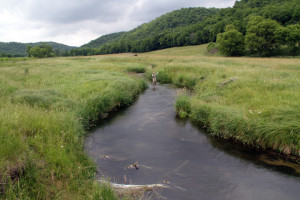Water Quality
What’s important for water quality?
By Jeff Hastings, Project Manager, Driftless Area Restoration Effort (DARE), Trout Unlimited

Every drop of water on your land is connected: from rain on the hilltops to water in the valley streams below. This is why the water quality in streams reflects the overall health of the land – similar to how a blood draw tells a doctor about a patient’s general health.
While a dirty stream is easy to spot, however, diagnosing the underlying causes of poor water quality is often much harder. When evaluating the water quality of your stream, start with the A-B-Cs.
A is for access
Are domestic animals pastured near your stream or drinking from it? Is livestock or equipment moving through your stream? If so, find ways to provide access while protecting water quality. When animals are grazing nearby, you can keep them away from delicate streambank soils and vegetation with fencing. Stream access points, such as cattle ramps and crossings, can also be located to minimize damage and engineered to withstand heavy traffic.
B is for banks
Streambanks, the sides of the stream, ideally should be gently sloped and covered with grasses. Steep banks with no vegetation are very prone to collapsing into the stream, but even vegetated streambanks can be a problem.

Trees growing along streambanks tend to shade out understory grasses, leaving the ground bare and prone to erosion. Streambank improvements often include removing shallow-rooted trees, sloping back the banks, and planting cool- and warm-season grasses.
C is for channel
The channel is the physical shape of the stream both along its length and in cross section. A healthy stream meanders back and forth, slowing water flow and creating more diverse habitats.
Over the years, many streams in Wisconsin have been straightened, however, which increases the water speed and causes down-cutting and bank erosion.
In cross section, healthy streams are narrow and deep. Then, when the stream floods, rising waters should reach the top of the banks and spread out over a broad floodplain.
You’ve learned the A-B-Cs. Now what?
Knowing your A-B-Cs puts you in a much better position to address the underlying problem. If you suspect that improvements to any of the A-B-Cs would benefit water quality on your property, contact your local County Land Conservation Department (LCD) or Natural Resource Conservation Service (NRCS) office. These agencies offer technical and financial assistance to landowners and are available in every county.
